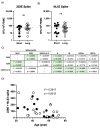Persistent COVID-19 Symptoms Minimally Impact the Development of SARS-CoV-2-Specific T Cell Immunity
- PMID: 34063463
- PMCID: PMC8155927
- DOI: 10.3390/v13050916
Persistent COVID-19 Symptoms Minimally Impact the Development of SARS-CoV-2-Specific T Cell Immunity
Abstract
SARS-CoV-2 represents an unprecedented public health challenge. While the majority of SARS-CoV-2-infected individuals with mild-to-moderate COVID-19 resolve their infection with few complications, some individuals experience prolonged symptoms lasting for weeks after initial diagnosis. Persistent viral infections are commonly accompanied by immunologic dysregulation, but it is unclear if persistent COVID-19 impacts the development of virus-specific cellular immunity. To this end, we analyzed SARS-CoV-2-specific cellular immunity in convalescent COVID-19 patients who experienced eight days or fewer of COVID-19 symptoms or symptoms persisting for 18 days or more. We observed that persistent COVID-19 symptoms were not associated with the development of an overtly dysregulated cellular immune response. Furthermore, we observed that reactivity against the N protein from SARS-CoV-2 correlates with the amount of reactivity against the seasonal human coronaviruses 229E and NL63. These results provide insight into the processes that regulate the development of cellular immunity against SARS-CoV-2 and related human coronaviruses.
Keywords: COVID-19; SARS-CoV-2; T cells; cellular immunity; symptom duration.
Conflict of interest statement
S.J.T. reports other from Pfizer, during the conduct of the study; personal fees from Merck, personal fees from Sanofi, personal fees from Takeda, personal fees from Themisbio, personal fees from Janssen, outside the submitted work. All other authors declare that the research was conducted in the absence of any commercial or financial relationships that could be construed as a potential conflict of interest.
Figures





References
Publication types
MeSH terms
Substances
Grants and funding
LinkOut - more resources
Full Text Sources
Medical
Molecular Biology Databases
Miscellaneous

